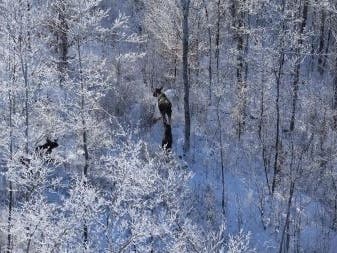NEW YORK — Moose can’t answer census questions and they live in some of the most remote areas of the state, but environmentalists have a toolbox of other means to track down the elusive beasts.
The New York State Department of Environmental Conservation (NYSDEC) announced the preliminary results of the second year of a moose research project in the Adirondack region. This year, 19 moose were fitted with GPS collars as part of a project to assess moose health and population.
Subscribe to
NYSDEC worked with researchers from the New York Cooperative Fish and Wildlife Research Unit and Cornell University’s College of Veterinary Medicine, the State University of New York’s College of Environmental Science and Forestry (SUNY ESF), and Native Range Capture Services to safely to catch, collar and collect biometric data on the 19 specimen moose.
“Each year of this valuable research advances our understanding of New York’s elk population and its critical role in our state’s biodiversity,” NYSDEC Commissioner Basil Seggos said in a statement announcing the second year of the project involving Cornell, SUNY ESF and Native Range capture services help us understand the health of our moose and allow us to make evidence-based management decisions to support this valuable species in the future.”
SEE ALSO: Have you caught a glimpse of the free-roaming Hudson Valley moose?
NYSDEC officials said the GPS collars will continue to provide location data and information on moose activity, patterns, movements and mortality. The data collected as part of this research effort will directly contribute to the further management of moose in New York.
The agency said previous moose research in the Adirondacks has helped researchers better understand adult moose survival and reproduction, but little is known about calf survival and distribution in New York. By collaring calves and monitoring their survival to adulthood, biologists will be able to study factors limiting moose population growth, such as the impact of parasites on young moose survival. These parasites, including winter ticks, brainworms, giant livers and associated diseases, have become an increasing management problem in the Northeast and elsewhere.
“There are several stressors in New York that could limit moose population growth,” said Angela Fuller, a Cornell University professor and director of the Fish and Wildlife Research Division of the US Geological Survey New York Cooperative. “Our research team consists of wildlife and disease ecologists and wildlife managers who work closely together to better understand the role parasites might play in limiting moose populations.
The collaborative research project is funded by a grant from the Federal Agency for Wildlife Restoration through the US Fish and Wildlife Service. These funds are collected through state excise taxes on firearms, ammunition, and archery equipment, and then allocated to states for wildlife conservation.
This year’s research also included sampling whitetail deer pellets and water sources to detect and better understand the prevalence and distribution of brainworm and giant liver fluke in the landscape. Larvae of these parasites are found in deer droppings, where they are ingested by slugs and then randomly consumed by moose as they forage for plants, the NYSDEC said.
In the fall of 2021, wildlife cameras were deployed by environmental officials to determine range overlap between deer and elk and to monitor hair loss in winter tick-infested elk.
“The ability to capture and sample live moose gives us a lot of valuable information about moose health,” said Krysten Schuler, wildlife disease ecologist and director of the Cornell Wildlife Health Lab. “Unfortunately, we are seeing more signs of parasites such as winter ticks and liver flukes in young moose, but this study allows us to identify treatment options for these problems.”
For additional information on moose biology, current research or to report moose sightingsvisit NYSDEC’s website.


Comments are closed.